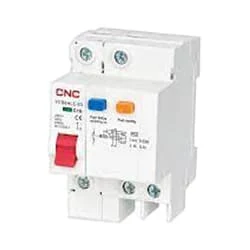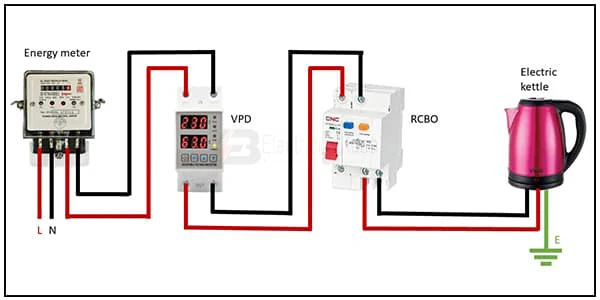over-voltage and Under voltage Protective Device:
Overvoltages are the voltages that exceed the normal or rated values which cause insulation damage to electrical appliances leading to short circuits. 220v ac line overvoltages protection saft line. If you want more clear details about this diagram please check our youtube video at the below post.
Under Volage Protective Device wiring:
Components Need for this Project:
You can get the components from any of the sites below:
- Single Phase Energy Meter [See Buy Click Amazon]
- VPD [See Buy Click Amazon]
- RCBO [See Buy Click Amazon]
- Electric Kettle [See Buy Click Amazon]
Read Also:
Components used to make the Over Voltage Protective Device:
01. Single Phase Energy Meter
 |
| Fig 02: Single Phase Energy Meter |
The measuring device with the help of which the electric power or energy of a circuit is measured is called Energy Meter (Energy Meter). Also called a watt-hour or kilowatt-hour meter. home appliances, we used a single-phase energy meter. The single-phase energy meter is directly connected between the line and the load. Both coils produce their magnetic fields, when the meter is connected to the supply line, and the load. Energy meters are used in homes and in industrial applications where we want to found that how much energy is being consumed by home appliances and electrical equipment.
02. VPD
 |
| Fig 03: VPD |
03. RCBO
 |
| Fig 04: RCBO |
RCBO Stands For Residual Current Circuit Breaker With Over-Current. These devices are designed to ensure the safe operation of electrical circuits breaker, triggering disconnection whenever an imbalance is detected. The other type of electrical fault is the overcurrent flow, which may take the form of an overload or short circuit. The residual current circuit breaker (RCBO) insulation should also operate within the corresponding specifications. This thereby provides protection for people, equipment, and property.
04. Electric kettle
 |
| Fig 05. Electric Kettle |
Water can be heated easily and quickly by using an electric kettle. The water capacity of an electric kettle starts from one to 10 liters. Take care that water does not stick to the kettle when it is connected to electricity.Terms of Use and Procedures. You can use a dry cloth to take extra care of the handle of the kettle. Use a separate electrical connection for electric kettles. Disconnect the electric kettle by turning off the switch. Electric kettles cannot be used for heating any liquid other than water.
Thank You for visiting the website. Keep visiting for more Updates.
Frequently Asked Questions
Under-voltage switch (22) can block only discharge power supply current, any recharge current may pass through it regardless of its switch Circuit diagram state. Over-voltage switch (28) can block only recharge power supply current when switched off and will always allow discharge Project system current to flow regardless of its switch power supply state.
Basically, under-voltage protection is nothing but a circuit diagram board that is placed between the mains and the power supply batteries, which is capable of detecting any under-voltage Circuit diagram condition. This protection device can easily check the phase-to-phase Circuit diagram voltage of the power supply device.
So it is important to use overvoltage and undervoltage Circuit diagram protection for electrical and electronic power supply appliances. This circuit diagram incorporates a low-voltage and high-voltage tripping mechanism to protect the Project system appliances from any damage due to voltage power supply fluctuation.
Overvoltage and overcurrent and protection work well for protecting a device that has a single maximum voltage and current — some devices' maximum current changes with the voltage. An example is a DC-to-DC converter, as its input can accept a power supply range of voltages, and it provides a regulated voltage Project supply output.
Overcurrent and protection devices such as fuses, breakers, and others limit the Circuit diagram current to the proper rate and disconnect the short circuits diagram. The type of overcurrent protection Project system used and the maximum current passing through the circuit diagram components determine the size of the power supply overcurrent protection project system.


Post a Comment
Do leave your comments